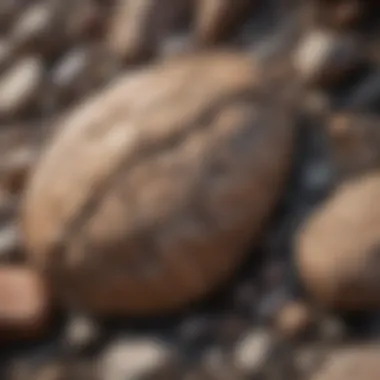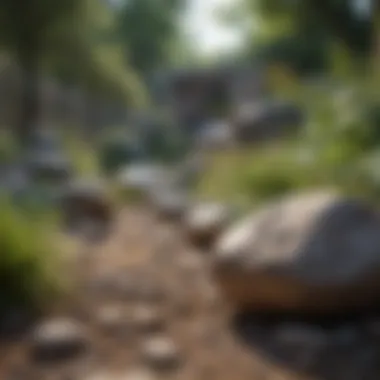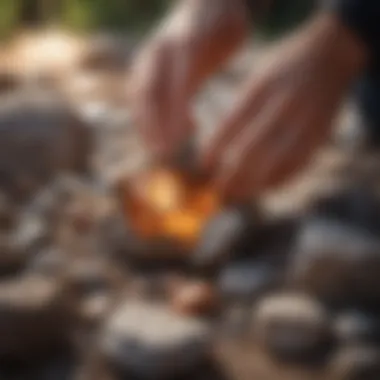Unveiling the Wonders of Backyard Rocks


Intro
Backyard rocks often go unnoticed, yet they embody stories of the Earth’s history. These stones can be both aesthetically pleasing and scientifically significant. The purpose of this article is to explore the various dimensions of backyard rocks, offering insights into their identification, preservation, and value. Understanding these natural elements enhances one's appreciation of the surrounding environment.
Rocks serve many roles in our gardens and landscapes. They provide unique textures, colors, and forms that enrich visual appeal. Beyond decoration, they can indicate geological conditions specific to the area, revealing local history and environmental changes. This article is structured to guide enthusiasts, both new and experienced, in recognizing the importance and diversity of backyard rocks.
Featured Collectible of the Month
Overview
This month, we highlight the granite rock, a common yet fascinating collectible. Known for its durability and variety of colors, granite is an igneous rock formed from cooled molten rock material. In gardens, its unique patterns add both beauty and character. Collectors may find granite in a range of hues, from pink to gray to black, often speckled with quartz or feldspar.
Historical Significance
Granite has been used for centuries in construction and sculpture, symbolizing strength and endurance. Historically, structures like the Great Pyramids of Giza utilized granite due to its robust nature. Its importance in various cultures demonstrates its enduring value. Understanding this background adds context to its significance in individual collections today.
Identification Techniques
Visual Characteristics
Identifying different types of rocks can be particularly engaging. For granite, consider its coarse grain and crystalline texture. Its color variations often depend on mineral content. When examining other backyard rocks, look for unique features that can aid in identification, such as:
- Texture (smooth, rough, coarse)
- Color (single, blended, or layered)
- Hardness (scratch tests can help)
Resources for Identification
Several resources are available for those seeking to learn more about backyard rocks. Useful references include:
- Wikipedia: Rock
- Britannica: Rock Formation
- Online communities such as Reddit and Facebook groups offer platforms to share discoveries and ask questions.
"Understanding rocks is more than just a hobby; it connects us to the Earth’s past and present."
By using these identification techniques and utilizing available resources, collectors can enhance their skills. Ultimately, this guide aims to cultivate a deeper appreciation for backyard rocks. Both the aesthetic and educational roles of these geological wonders merit exploration.
Prologue to Backyard Rocks
Understanding the topic of backyard rocks is essential in appreciating the natural environment around us. Rocks, often overlooked, are not mere elements of the landscape; they embody a wealth of geological history and aesthetic potential. This section introduces how rocks, found in gardens or vacant lots, connect to larger geological processes. By delving into the characteristics and formations of these formations, one can cultivate an informed perspective when examining these natural artifacts.
Understanding the Basics
Backyard rocks encompass a variety of types and formations. They can be igneous, sedimentary, or metamorphic, each representing distinct geological processes. For example, igneous rocks form from cooled volcanic lava, while sedimentary rocks are created through the accumulation of sediments over time. It's important to recognize these classifications as they reflect not just composition but also the environmental conditions of their formation.
In many areas, backyard rocks can tell a story about the earth's history. A granite boulder might suggest a history of volcanic activity, while layers of sandstone may indicate ancient bodies of water. Hence, recognizing these rocks gives insight into regional geology and can enhance one’s appreciation for local environments.
Significance in Geology
The significance of backyard rocks extends far beyond their surface appearance. Each type has a distinct role in the earth’s processes. Rocks undergo constant change from tectonic movements, erosion, and weathering. They are integral to understanding geological time scales. Often, these backyard specimens can act as educational tools for geology enthusiasts.
Beyond academic interest, rocks contribute to soil composition and ecology. They influence local plant growth and habitat formation by affecting water drainage and nutrient availability. Moreover, minerals found in these rocks can support entire ecosystems.
Geology is not just about studying vast mountains or deep canyons; even small, seemingly ordinary rocks have fascinating stories to tell.
Types of Backyard Rocks
Understanding the different types of backyard rocks is crucial for enthusiasts and collectors. Each type has unique characteristics, forming a diverse landscape both visually and geologically. These rocks not only enhance the aesthetic appeal of gardens and yards but also provide insights into the Earth’s history and processes. By categorizing rocks, one can appreciate their formation and significance within the environment.
Igneous Rocks
Igneous rocks are one of the primary types you may encounter in your backyard. They originate from the solidification of molten material. This process results in diverse textures and colors, leading to fascinating geological discussions.
Characteristics
Igneous rocks typically possess a crystalline structure, which stems from the cooling of magma or lava. This cooling can occur slowly beneath the Earth's surface, forming intrusive rocks, or rapidly on the surface, resulting in extrusive rocks. An essential characteristic of igneous rocks is their mineral composition, which can vary widely. For example, they might contain quartz, feldspar, or mica. Understanding these properties allows enthusiasts to identify the rock types accurately.
The crystalline structure is a beneficial aspect as it often signifies the rock's durability and resistance to weathering, making it ideal for landscaping features.


Common Examples
In backyards, one might find common examples of igneous rocks, such as granite and basalt. Granite, often used in countertops and outdoor features, is characterized by its coarse-grained texture and variety of colors, which can range from pink to gray. Basalt, on the other hand, is a fine-grained rock typically dark in color and associated with volcanic activity.
Both granite and basalt have unique features that make them popular choices for gardeners looking for natural materials.
Sedimentary Rocks
Sedimentary rocks are formed through the accumulation of minerals and organic materials over time. They cover a significant portion of the Earth’s crust and are integral to understanding geological processes.
Formation Process
The formation of sedimentary rocks involves several stages: weathering, compaction, and cementation. Initially, existing rocks break down into smaller particles due to weathering. These particles are then transported by water, wind, or ice and accumulate in layers. Over time, pressure compresses these layers, and minerals precipitate out of solution, binding the particles together.
The layering process is particularly interesting, as it tells the story of the environment in which the rock was formed, making it a valuable tool for educational purposes.
Popular Varieties
Common varieties of sedimentary rocks include sandstone, limestone, and shale. Sandstone is often recognized for its gritty texture and is frequently used in walkways and patios. Limestone is essential for its neutral color and ability to support various plants in garden settings. Shale, while less commonly used, can be an intriguing find as it often contains fossils that provide insight into past life forms.
Each of these rocks offers different functional benefits for landscaping, enhancing both aesthetic and ecological attributes in the backyard.
Metamorphic Rocks
Metamorphic rocks transform from pre-existing igneous or sedimentary rocks through heat and pressure. This category exemplifies the dynamic nature of Earth's geology, which reshapes materials over time.
Transformation Factors
The transformation of a rock into metamorphic rock involves key factors like temperature, pressure, and the presence of fluids. This process can significantly change the mineral composition and structure, resulting in new textures. For instance, the original limestone can become marble, showcasing a crystalline structure that is highly valued in architecture and design.
Understanding these transformation factors is vital for collectors, as it provides context for the rocks' properties and their potential uses.
Notable Types
Prominent metamorphic rocks include schist, gneiss, and slate. Schist is known for its layered appearance and often contains shiny mica flakes, making it visually appealing. Gneiss, characterized by its banding, can reflect a wide range of colors and has structural integrity, rendering it suitable for outdoor features. Slate is frequently used for roofing and flooring due to its durability and smooth texture.
Each notable type provides collectors with unique insights into geological history while also serving functional roles in homes and gardens.
Understanding the various types of backyard rocks deepens appreciation for their natural beauty and significance. This knowledge not only informs landscaping choices but also encourages further exploration of the geological world.
Identifying Backyard Rocks
Identifying backyard rocks is an integral part of understanding their role in both the environment and personal enjoyment. Knowing how to recognize different types of rocks can enhance the appreciation of one’s surroundings and foster a deep connection to nature. Moreover, identification plays a crucial role in activities such as landscaping, educational projects, and even scientific study.
Physical Characteristics
Physical characteristics are the primary means by which rock identification occurs. Three significant traits include color, texture, and weight, each providing unique insights into the rock’s composition and origin.
Color
The color of rocks can vary widely and often indicates mineral content. For instance, rocks rich in iron typically exhibit reddish hues, while those with quartz may appear lighter. The variety of colors contributes to the aesthetic appeal of rocks in landscaping.
Key Characteristic: The strong visual impact of color can help in making an immediate identification. For example, a vibrant green rock might suggest the presence of copper minerals.
Unique Feature: Color can change depending on factors like weathering or exposure to elements. This variability can sometimes mislead identification efforts, thus it should not be the only characteristic examined.
Texture
Texture refers to the surface feel and structure of a rock. It can be rough, smooth, or even layered, providing essential clues about its formation. For example, sedimentary rocks have a finely grained texture, often indicating their formation from accumulated sediments.
Key Characteristic: Texture contributes to the classification of rocks and can signal the rocks' history. A rough texture may suggest volcanic activity, while a smoother texture could imply prolonged weathering.
Unique Feature: Texture can significantly affect a rock's usability in landscaping. For example, rough stones may better serve as natural pathways compared to smooth pebbles, which might shift underfoot.
Weight
Weight is a practical aspect to consider, particularly when moving or using rocks in landscaping. Heavier rocks, like granite, are often more durable and suitable for building purposes, while lighter ones might be used for decorative elements in gardens.


Key Characteristic: The specific weight of certain rocks can also hint at their mineral content. Heavier rocks often have denser minerals, which can be beneficial in various projects.
Unique Feature: Weight can be misleading in identification since some lightweight rocks can be deceptively tough. Hence, understanding the relationship between weight and the rock's composition is necessary.
Testing Methods
To accurately identify backyard rocks, one can employ various testing methods that provide reliable results about their composition.
Hardness Test
The hardness test evaluates a rock's resistance to scratching. Using the Mohs scale of hardness, one can compare the rock against known materials, like glass or a fingernail, to determine its hardness.
Key Characteristic: Hardness is an effective method for discerning mineral composition. For instance, a rock that scratches glass has a hardness greater than 5.5.
Unique Feature: The hardness test requires no special equipment, making it accessible for anyone interested in rock identification. However, it may not be foolproof if the rock contains multiple minerals of varying hardness.
Acid Test
The acid test is a useful way to identify carbonate minerals, such as calcite. When a small quantity of vinegar or hydrochloric acid is applied, effervescence or fizzing indicates a reaction due to carbon dioxide release.
Key Characteristic: This simple test can quickly confirm or rule out the presence of certain minerals, making it especially useful for those wanting to learn more about their rocks.
Unique Feature: While effective, the acid test should be conducted with caution and appropriate safety measures, as the acid can also pose risks to skin and surfaces. Knowledge of the mineral composition is important before carrying out this test.
Caring for Backyard Rocks
Caring for backyard rocks is a vital aspect of maintaining both their aesthetic appeal and their geological integrity. Many collectors overlook the significance of proper care, often focusing solely on acquisition. However, understanding how to clean, store, and display rocks ensures that they remain a source of pride and educational value. Collectors who invest time into the upkeep of their rocks will find that their efforts lead to a deeper appreciation and understanding of their natural treasures.
Cleaning Techniques
Chemical Cleaners
Chemical cleaners play a crucial role in the maintenance of certain types of rocks, especially those that have accumulated dirt and debris. These cleaners are designed to effectively remove stains and residues without damaging the stone. A key characteristic of chemical cleaners is their ability to deep clean porous materials, allowing for the restoration of a rock's original appearance.
The advantage of chemical cleaners lies in their efficiency. They can quickly dissolve tough stains, making them a popular choice among collectors looking for swift results. However, it is essential to choose the right cleaner for specific rock types, as some chemicals might react adversely with certain minerals. Moreover, caution is needed, as the strong nature of these products can be harmful to the environment.
Natural Cleaners
Natural cleaners offer an alternative method for cleaning backyard rocks. These options typically include common household items like vinegar and baking soda. A notable feature of natural cleaners is their environmentally friendly composition. They lack harsh chemicals that may cause harm to the surrounding ecosystem.
Using natural cleaners can be beneficial because they can be gentle on the rock while still effectively removing surface grime. Their biggest disadvantage is that they may not always be as effective on stubborn stains compared to chemical cleaners. Thus, collectors must gauge the cleaning context to decide which method best suits their needs.
Storage Considerations
Indoor Storage
Indoor storage is often recommended for rocks that are particularly delicate or valuable. This method helps protect rocks from environmental factors like weathering and pollution. A key characteristic of indoor storage is its controllable conditions; collectors can maintain stable temperature and humidity levels, which are essential for the preservation of certain types of minerals.
Furthermore, storing rocks indoors allows for easier access and display opportunities. However, it can limit the exposure of rocks to natural light, which some collectors believe is essential for aesthetic appreciation.
Outdoor Display
Outdoor display, on the other hand, showcases backyard rocks to the natural world. When rocks are used for landscaping features or garden decorations, they can enhance the visual appeal of outdoor spaces. A notable characteristic of outdoor display is its ability to integrate rocks with the environment, allowing them to participate actively in a natural landscape.
While outdoor display can be visually stunning, it comes with risks. Rocks exposed to weather conditions might suffer erosion or discoloration over time. Collectors must weigh the benefits of aesthetic enjoyment against the potential for environmental damage when deciding upon this storage option.
Landscaping with Rocks
Landscaping with rocks is more than mere aesthetic enhancement; it transforms a backyard into a unique environmental showcase. Beyond that, rocks provide structural integrity to various designs and complement the existing flora. Their geological diversity brings different textures, colors, and patterns. Using these natural elements can improve drainage, serve as habitat for wildlife, and reduce the need for lawn maintenance.
When considering landscaping with rocks, it is essential to plan with purpose. Understanding the types of rocks available and their characteristics can significantly influence the overall design and function of your space. Here are some key benefits and considerations in using rocks for landscaping:
- Durability: Rocks are resilient to weather conditions. Unlike plants, they do not need replacing each season.
- Variety: From smooth river stones to rugged granite, the choices can match almost any style.
- Ecosystem: Rocks can provide habitat for small insects and other wildlife, contributing to the ecosystem's health.
- Low Maintenance: Once placed, rocks require minimal upkeep compared to traditional planting.
When weighing down these elements, consider your local environment and how rocks can fit in with existing wildlife and flora.
Creating Natural Pathways


Creating natural pathways in your garden or yard is a practical use of rocks. They can guide foot traffic while adding visual interest. Such pathways can be made from various sizes and shapes of rocks, providing a rustic appeal that blends well with nature.
Some considerations while creating these pathways include:
- Layout Planning: The pathway should complement your natural landscape while not obstructing plant growth. Use larger stones for sturdiness and smaller gravel for fill.
- Functionality: Think about where you want people to walk and how it fits the surrounding environment. This not only ensures a clear route but also minimizes environmental disruption.
- Safety: Ensure that the rocks are stable and not prone to shifting. This reduces the risk of tripping.
Using Rocks as Edging
Using rocks as edging can define spaces within your yard while providing a clean, structured appearance. It can be applied along flower beds, vegetable patches, or pathways, effectively segmenting the landscape without overpowering it.
Some practical tips for using rocks as edging include:
- Consistency: Choose rocks that are similar in color and texture for a unified look.
- Placement: Position the rocks in such a way that they create a natural boundary without being too rigid. This helps maintain the organic feel of the landscape.
- Height: Varying the height of the rocks can create visual interest and also help prevent soil erosion.
The careful placement of rocks can enhance both the beauty and functionality of your backyard landscape, making it not just a space to admire but also one to enjoy.
In summary, landscaping with rocks offers numerous advantages that combine aesthetics with functionality. Informed choices and thoughtful design can make a remarkable difference in utilizing these natural elements.
The Educational Value of Rocks
Backyard rocks offer immense educational value that can significantly enrich our understanding of both geology and ecology. This value manifests through hands-on learning experiences and engagement with scientific inquiry. By integrating rocks into educational activities, learners can not only appreciate these natural components but also cultivate critical thinking skills and scientific literacy.
Teaching Tools
Hands-On Learning
Hands-on learning stands out as a powerful method to teach about rocks. This approach emphasizes active participation, allowing individuals to manipulate objects directly. It encourages exploration and fosters a tangible connection with the subject matter.
One key characteristic of hands-on learning is its interactivity. When students interact with rocks, they engage more deeply with geological concepts, making abstract ideas more concrete. This method is especially beneficial for tactile learners who thrive on physical engagement.
A unique feature of hands-on learning is its potential to cater to a range of educational settings. It can be implemented in classrooms, outdoor environments, or during field trips. However, challenges like accessibility and safety may arise in outdoor settings, requiring careful planning.
Field Trips
Field trips complement classroom learning by providing a change in environment that can enhance understanding. Visiting geological sites or natural parks allows students to observe rocks in their natural context. This firsthand experience can transform theoretical knowledge into practical insights.
One notable characteristic of field trips is their immersive nature. Learners gain exposure to real-world geological formations, enabling them to see variations and formations they might not encounter in textbooks. This direct interaction is valuable for making connections between theory and practice.
The unique feature of field trips is their capacity to inspire curiosity. Being in a natural setting can spark questions and discussions that lead to deeper investigations. However, organizing such trips can be resource-intensive, requiring time, funding, and logistics.
Fostering Scientific Inquiry
Fostering scientific inquiry is a crucial aspect of understanding backyard rocks. This inquiry encourages individuals to ask questions, formulate hypotheses, and conduct experiments related to geological phenomena. Engaging in scientific inquiry enhances critical thinking and problem-solving skills, making it an invaluable component of education.
Through inquiry, learners develop a robust understanding of the rock cycle, mineral compositions, and environmental interactions. As participants engage with their surroundings, they become more aware of geological processes shaping their immediate environment.
In summary, the educational value of backyard rocks is significant. By leveraging hands-on learning techniques and facilitating field trips, educators can foster scientific inquiry. Overall, this approach not only enriches knowledge but also cultivates a lasting appreciation for the natural world.
Closure
The conclusion serves as a pivotal element in reinforcing the key themes discussed throughout the article. It synthesizes the knowledge gained from exploring backyard rocks, emphasizing their geological significance, aesthetic contribution to landscapes, and educational value. This section underscores the diverse roles that these natural forms play in both environmental settings and human activities.
Individuals who engage with backyard rocks can benefit greatly. This guide has illuminated how rocks can serve as educational tools, encourage scientific inquiry, and foster a deeper connection with nature.
In summary, backyard rocks represent more than mere physical specimens; they are gateways to understanding the Earth’s history and improvement of our surroundings.
Summary of Insights
Each section of this article has contributed essential insights into the world of backyard rocks. From understanding the basic types and characteristics of rocks to learning about their care and landscaping uses, it is clear that there is much depth to this subject. The following points encapsulate the core insights:
- Types of Rocks: Knowledge of igneous, sedimentary, and metamorphic rocks enhances our appreciation and identification skills.
- Recognition Skills: Mastery of physical characteristics aids enthusiasts in identifying rocks based on tangible traits.
- Care and Maintenance: Proper cleaning and storage practices extend the beauty and lifespan of rocks.
- Landscaping Applications: Incorporating rocks into garden design can create striking and sustainable features.
- Educational Benefits: Backyard rocks provide an ideal resource for hands-on learning, fostering curiosity in geology and science.
"Backyard rocks are not just part of our environment; they offer a window into our planet's geological past and potential present."
Encouragement for Exploration
As you reach the conclusion of this article, take a moment to reflect on the wonders that lie in your own backyard. Exploration does not stop here; there is a rich tapestry of rock types and formations waiting for discovery.
Consider these points to fuel your curiosity:
- Personal Collection: Building your own rock collection can be a rewarding and informative hobby.
- Local Geology: Visit local parks or geological sites to discover and learn about native rock formations.
- Community Engagement: Joining local rock and fossil collecting groups can expand your knowledge and circle of friends.
Do not hesitate to seek information about the types of rocks in your area. Through exploration, hobbyists can uncover new specimens and deepen their understanding of geology, enriching their appreciation for the natural world. Additionally, resources like Wikipedia and Britannica offer valuable information for further learning.



